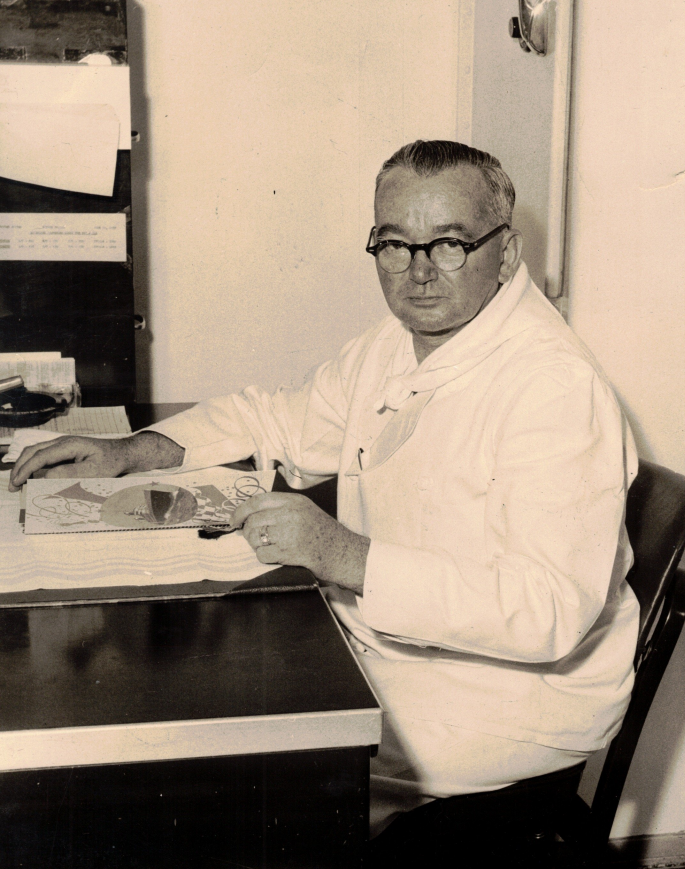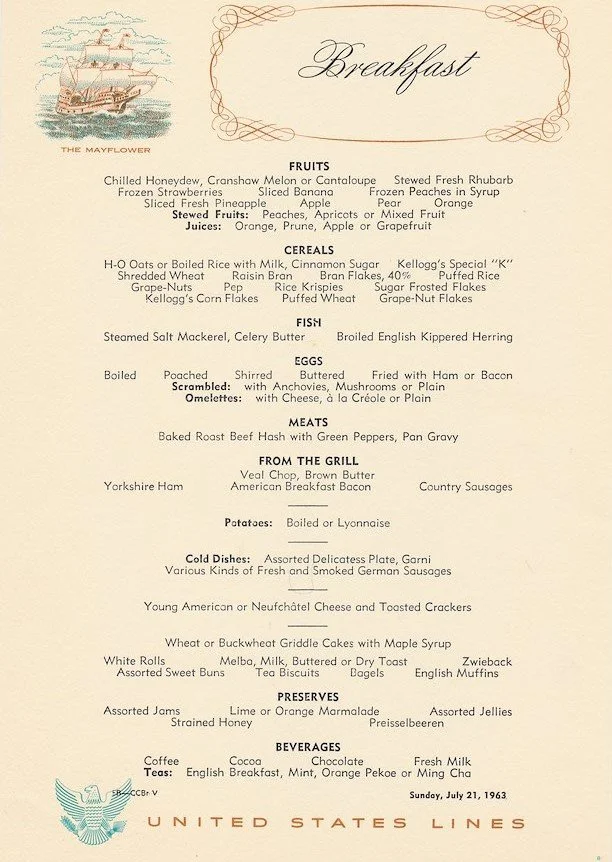FOOD TASTES BETTER AT SEA:
Dining Aboard the SS United States
Take a Seat | Setting the Table | What's on the Menu?
Innovation and Tech | Back of House | An Enduring Legacy
Guest Book | Shop
PREVIOUS: Setting the Table | NEXT: Innovation and Tech
WHAT’S ON THE MENU?
"The food is tremendous. They have a menu with so many different selections and everything is delicious.
It seems like we eat all day and we'll weigh a ton by the time we reach Bremerhaven."
- Letter from Joyce Reed to mother and father, 1966
WORLD WAR TWO
During World War II, food was carefully rationed, transforming staples like coffee and sugar into luxuries. Creative food scientists invented instant coffee and other ready-made meals to keep troops fed abroad. Following the war, America became the richest country in the world. Consumers had money to spend again. They were hungry for their favorite foods, for coffee, and newly interested in trying foreign cuisines too. Food from France, Italy, and China soon filled magazines, cookbooks, and television programs. Middle class housewives excitedly studied these new recipes.
The dining experience on the SS United States was emblematic of many of these post-war trends. The abundance of food offered on board was staggering compared to wartime rationing and famine. And each meal was intentionally international, offering cuisines from French to Italian to Spanish to Indian to Mexican.
"The very first meal I had was a huge steak and veggies. I cried and the waiter wanted to know what was wrong.
Well, in 1953, we still used ration books for food. So we were in trouble with my Mum if we didn’t clean our plate…
When I saw all that food I was very upset."
- Jean Nadine (Oldham) Parker
(1953 Tourist Class passenger)
Photo of Otto Bismarck at Desk. Undated.
SS United States Conservancy Collection. Courtesy of Otto's son, Fred Bismarck.
Otto Bismarck
Otto Bismarck, head chef of the SS United States, played a crucial part in the SS United States' appeal to a diverse potential pool of passengers. A German chef educated in high class European hotels, he offered a familiar "Continental" experience for European passengers, while intriguing Americans who were looking for something new. On the other hand, Bismarck's high-tech kitchen, equipped with machines like the Radarange, had a uniquely American charm.
"We are not believing much in canned foods.
We prefer to use the fresh turtle instead of the canned.
We like fresh fruits and vegetables better, too."
Otto Bismarck (New York Times, 1957)
"WHAT A PITY IT'S JUST 15 SUPERB MEALS!"
Diners of all classes could expect extravagant dishes; there were few differences between First, Cabin, and Tourist class offerings. This made food preparation and ingredient ordering simpler, especially since First Class and Cabin Class shared galley space. Ultimately, the difference between the classes lay in the presentation of the food and the separate dining rooms.
Passengers delighted in trying new foods of all kinds, from delicacies like Lobster Tail to Turtle Soup. Passengers immigrating to America reacted with equal parts surprise and confusion at the American food, like corn on the cob.
Some dishes offered onboard were original recipes, like Bombe Glacée "United States." Recipes developed by Head Chef Otto Bismarck bore his name, including Bismarck Herring in Sour Cream and Velouté Bismarck. Punny dish names included nods to American history and culture, like Clara Barton Salad. Passengers could order a dizzying variety of potatoes (boiled, mashed, baked, french fried, candied sweet, chips), cheese (young American, Limberger, Tilsiter, Boursin, Gruyere, Gouda, Brie, Swiss) eggs (boiled, poached, shirred, buttered, fried, scrambled, and omelette).
Many of the same dishes repeated across breakfast, luncheon, and dinner. Ingredients were creatively reused and remixed. Passengers could always order herring, a staple seafaring food for hundreds of years, for breakfast, lunch, and dinner.
With advance notice to the Dining Room Stewards, passengers with dietary restrictions could receive special made dishes. From 1952 to 1964, freshly prepared Kosher food was offered to Jewish passengers. A Head Kosher Chef directed the Kosher Kitchen, which was also outfitted with special dining ware and silverware. After the Kosher Kitchen closed, Jewish passengers were instead offered tinned Kosher foods and fresh vegetables and fruits.
"Yes, I think my favorite meal was the roasted duck with raisin sauce. I had never eaten duck."
- Junia (June) Sam
(1954 Tourist Class passenger)
"We had never seen people eat corn on a cob. Our German farm animals ate those!!! Needless to say, we were in the States a while before we tasted them and have enjoyed them ever since!"
- Rita Haense Sharkey
(1956 Tourist Class passenger)
THE HISTORY OF DINING AT SEA: LECTURE BY SIMON SPALDING
GALA NIGHT
First Class Gala Dinner Menu, August 1962.
SS United States Conservancy Collection. Courtesy of Florence Connor.
First Class Gala Dinner Menu, August 1953.
SS United States Conservancy Collection. Courtesy of Florence Connor.
Every voyage concluded with Gala Night, a party celebrating the last night at sea. Passengers wore their nicest clothes for the celebrations. Streamers and party hats were passed out to all. Special menus included dishes like Kangaroo Tail Soup. The soup was painstakingly prepared using Kangaroo tail imported frozen from New Zealand. Another mainstay was Green Turtle Soup, prepared with fresh turtle. According to the New York Times, every voyage included a live reptilian passenger, averaging at 200lbs.
”There was a fancy gala one night… my mother, younger sisters and I were given fancy paper party hats to wear. I don't remember much about the voyage, but I remember my delight at receiving a wonderful party hat.”
Inga Bowyer
(1953 Cabin Class passenger)"I was most impressed with the very fancy dining room and the Gala Dinner menu. As a young man from a very middle class family, I had heard of ‘pheasant under Glass’, but then it was on the menu! I remember wearing a suit to dinner and that it was best behavior… We all felt famous!”
Gael Curry
(1962 passenger)
"We always loved Gala Night even as children. Our parents would look so glamorous and later my parents always bought me a new evening dress for the event. "
Betsy Stettinius
(frequent passenger)













